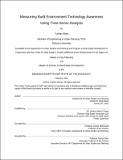Measuring built environment technology awareness using time-series analysis
Author(s)
Wang, Yuehan, M.C.P. Massachusetts Institute of Technology.
Download1265091056-MIT.pdf (5.342Mb)
Other Contributors
Massachusetts Institute of Technology. Department of Urban Studies and Planning.
Massachusetts Institute of Technology. Center for Real Estate. Program in Real Estate Development.
Terms of use
Metadata
Show full item recordAbstract
This study responds to the accelerating application of technologies in the building environment and lack of academic research exploring how these technologies are developed over time. "Built environment technologies" refers to technologies that impact the built environment, including architecture, construction, urban planning, and real estate. This study employs a "technology awareness metric" system to quantitatively trace and analyze the "invention, innovation, and diffusion" process of built environment technologies. The technology awareness metric system contains three parts: 1) research and development awareness, defined by published academic papers and granted patents; 2) capital market awareness, signaled by the number of companies established and the amount of historical funding; and 3) general public awareness, measured by Twitter activities and Google Search traffic. Using Engle-Granger two-step cointegration test method, this study compares the awareness time-series of 208 built environment technologies in pairs. The results show that different awareness measures coexist and cointegrate, suggesting that invention, innovation, and diffusion are not necessarily successive. More specifically, papers and patents tend to cointegrate, as do companies and funding; Twitter activities tend to cointegrate with companies, funding, papers, and patents. Furthermore, general public awareness demonstrates the highest uniformity in time-series patterns, followed by capital market awareness, and research and development awareness.
Description
Thesis: M.C.P., Massachusetts Institute of Technology, Department of Urban Studies and Planning, February, 2021 Thesis: S.M. in Real Estate Development, Massachusetts Institute of Technology, Program in Real Estate Development in conjunction with the Center for Real Estate, February, 2021 Cataloged from the official PDF of thesis. Includes bibliographical references (pages 72-76).
Date issued
2021Department
Massachusetts Institute of Technology. Department of Urban Studies and Planning; Massachusetts Institute of Technology. Center for Real EstatePublisher
Massachusetts Institute of Technology
Keywords
Urban Studies and Planning., Center for Real Estate. Program in Real Estate Development.